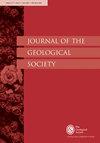Magnetic fabric of OPS mélanges: a tool for unravelling protracted histories of oceanic plates from sea-floor spreading to tectonic emplacement into accretionary wedges
IF 3
3区 地球科学
Q2 GEOSCIENCES, MULTIDISCIPLINARY
引用次数: 0
Abstract
Multiple magnetic fabrics, referred to as F1–F5, were revealed through the anisotropy of magnetic susceptibility (AMS) in an Ocean Plate Stratigraphy (OPS) mélange of the Neoproterozoic–Cambrian Blovice accretionary complex, Bohemian Massif. The fabrics postdate the mélange formation and rotation of basalt blocks within the matrix and are interpreted in terms of a complex structural history of the mélange. Excluding local fabrics, the F1 fabric formed earlier along the mélange belt, recording shortening of the accretionary wedge front, whereas the higher-grade F4 fabric pervasively overprinted both blocks and matrix in the SW part of the belt, recording shearing and vertical shortening at deeper structural levels closer to a megathrust surface. The preservation of angular relationships between the F1 and F4 fabrics across different parts of mélange suggests that blocks were only strained and not rotated during deformation, exemplifying the notion that the OPS mélanges may be a product of deformation at very shallow levels. Finally, the F1–F5 fabrics may be viewed as snapshots in a protracted evolution of OPS mélanges, where earlier fabrics in basalt blocks may record the travel path of an oceanic plate from mid-ocean ridge towards the trench, before being overprinted in the accretionary wedge. Thematic collection: This article is part of the Ophiolites, melanges and blueschists collection available at: https://www.lyellcollection.org/topic/collections/ophiolites-melanges-and-blueschists Supplementary material: https://doi.org/10.6084/m9.figshare.c.7008173OPS mélanges的磁结构:揭示海洋板块从海底扩张到构造置入增生楔的漫长历史的工具
在波希米亚丘陵地带新新生代-寒武纪布洛维采积复合体的海洋板块地层(OPS)中,通过磁感应强度各向异性(AMS)揭示了多个磁性构造,称为 F1-F5。这些织构出现在混杂岩层形成和基质中玄武岩块旋转之后,可从混杂岩层复杂的构造历史角度进行解释。除去局部构造外,F1构造沿熔岩带形成较早,记录了增生楔前沿的缩短,而较高级的F4构造在熔岩带西南部的岩块和基质上普遍覆盖,记录了更深的构造层的剪切和垂直缩短,更接近大地壳表面。F1和F4织物之间的角度关系在混杂带的不同部分都得到了保留,这表明在变形过程中,岩块只受到拉伸而没有发生旋转,这充分说明了OPS混杂带可能是极浅层变形的产物这一观点。最后,F1-F5构造可被视为大洋板块混合岩漫长演化过程中的一个缩影,玄武岩块中的早期构造可能记录了大洋板块从大洋中脊向海沟移动的路径,然后被覆盖在增生楔中。 专题集:本文是蛇绿岩、熔岩和蓝晶岩论文集的一部分,可在以下网址查阅: https://www.lyellcollection.org/topic/collections/ophiolites-melanges-and-blueschists 补充材料:https://doi.org/10.6084/m9.figshare.c.7008173
本文章由计算机程序翻译,如有差异,请以英文原文为准。
求助全文
约1分钟内获得全文
求助全文
来源期刊

Journal of the Geological Society
地学-地球科学综合
CiteScore
6.00
自引率
3.70%
发文量
68
审稿时长
6-12 weeks
期刊介绍:
Journal of the Geological Society (JGS) is owned and published by the Geological Society of London.
JGS publishes topical, high-quality recent research across the full range of Earth Sciences. Papers are interdisciplinary in nature and emphasize the development of an understanding of fundamental geological processes. Broad interest articles that refer to regional studies, but which extend beyond their geographical context are also welcomed.
Each year JGS presents the ‘JGS Early Career Award'' for papers published in the journal, which rewards the writing of well-written, exciting papers from early career geologists.
The journal publishes research and invited review articles, discussion papers and thematic sets.
 求助内容:
求助内容: 应助结果提醒方式:
应助结果提醒方式:


